What's inside a 1960s American Civil Defense Geiger Counter
After taking apart my new Ukrainian Sintex geiger counter, I realized that I've never gone over my main radiation detector, a CDV-700 geiger counter. This device was made sometime around 1961 and still works extremely well. This device is the most sensitive radiation counter that I own, and is capable of easily detecting beta and gamma radiation of a wide range of energies.
The circuit is somewhat simple and allows radiation dosage/count readings to be displayed on a magnetic gauge. A knob allows you to adjust the dosage scale from everyday background radiation levels to nuclear-apocalypse level dosages.
Essentially every radiation experiment I've done (testing sources, making X-rays, verifying shielding) was done primarily with this device.
CDV-700: My favorite Geiger counter so far
Produced in the late 1950s and early 1960s, the CDV-700 Geiger counter line was commissioned by the US government to civil defense agencies to be used in the event of a radioactive accident or nuclear war with the USSR. The later models used standard D-cell batteries, which makes them still useful to this day. They were build incredibly well. The devices themselves are large yellow boxes made of thick steel, and painted bright yellow. The top of the device contains a knob that turns the device on and selects a dosage reading, the Geiger-Muller tube probe, and a circular gauge which shows radiation levels around the probe. The probe itself is clamped down by a metal handle which can be used to easily carry the detector around.
My CDV-700 is a Model 6A, which indicates that it was manufactured in 1961. From a stamp on the casing, the device was apparently made in Ohio. Here's mine:
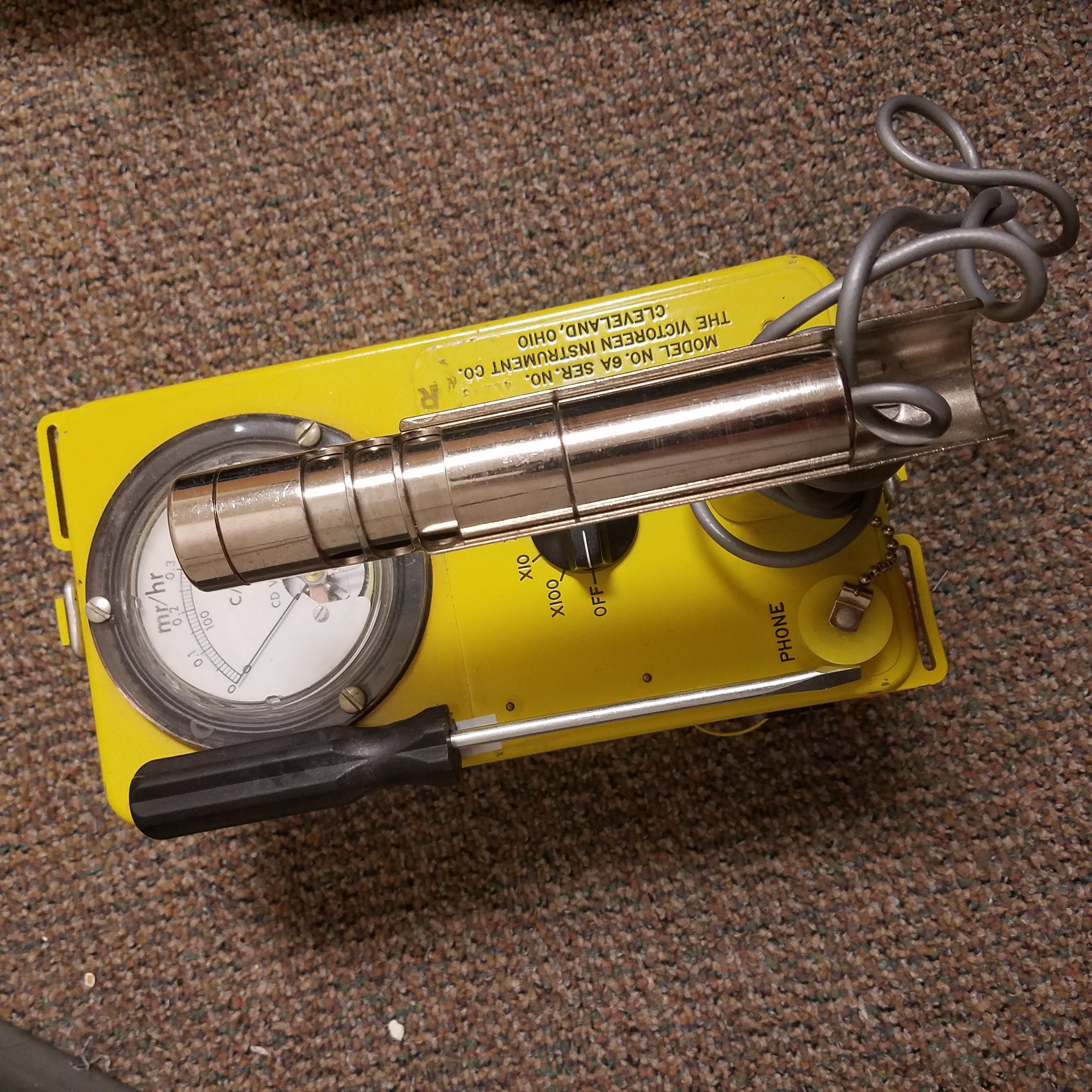
After being in use for a few decades, these detectors were sold en masse as surplus, allowing many ordinary people to get their hands on them. This means that they are now all over websites like Ebay, and are an amazing option for getting a good Geiger counter without spending hundreds of dollars.
After sifting through many listings, I got my CDV-700 for about $50 over a year ago by taking a risk and buying one that hadn't been verified as working. I was lucky for once and it arrived in perfect working condition.
The metal Geiger-Muller tube mounted on top of the detector can be removed and used remotely, connected by a long grey cable. This tube detects radiation by measuring high voltage pulses across the tube caused by ionization avalanches produced by incoming radiation.
On the tube is a rotating, thick brass shield. This shield blocks almost all incoming beta radiation, allowing the detector to only pick up the more penetrating gamma radiation. When the shield is open, the tube can pick up both types of radiation easily, down to somewhat low energy levels (I've picked up X-Rays as low as 15 keV on this device from my homemade X-Ray tubes).
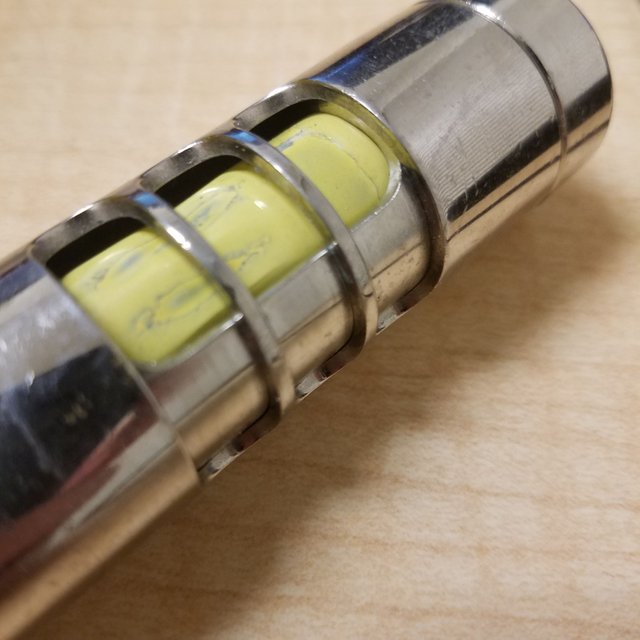
A large white circular gauge displays radiation level information. The gauge measures dosages in Rads (not Roentgens as I claimed in a previous post - for some reason most radiation units start with R...) and also displays a more accurate CPM value. CPM is counts-per-minute, and is simply the number of radiation strikes detected in a one minute period. The CPM value displayed on the gauge will be perfectly accurate while the rad readings are approximate.
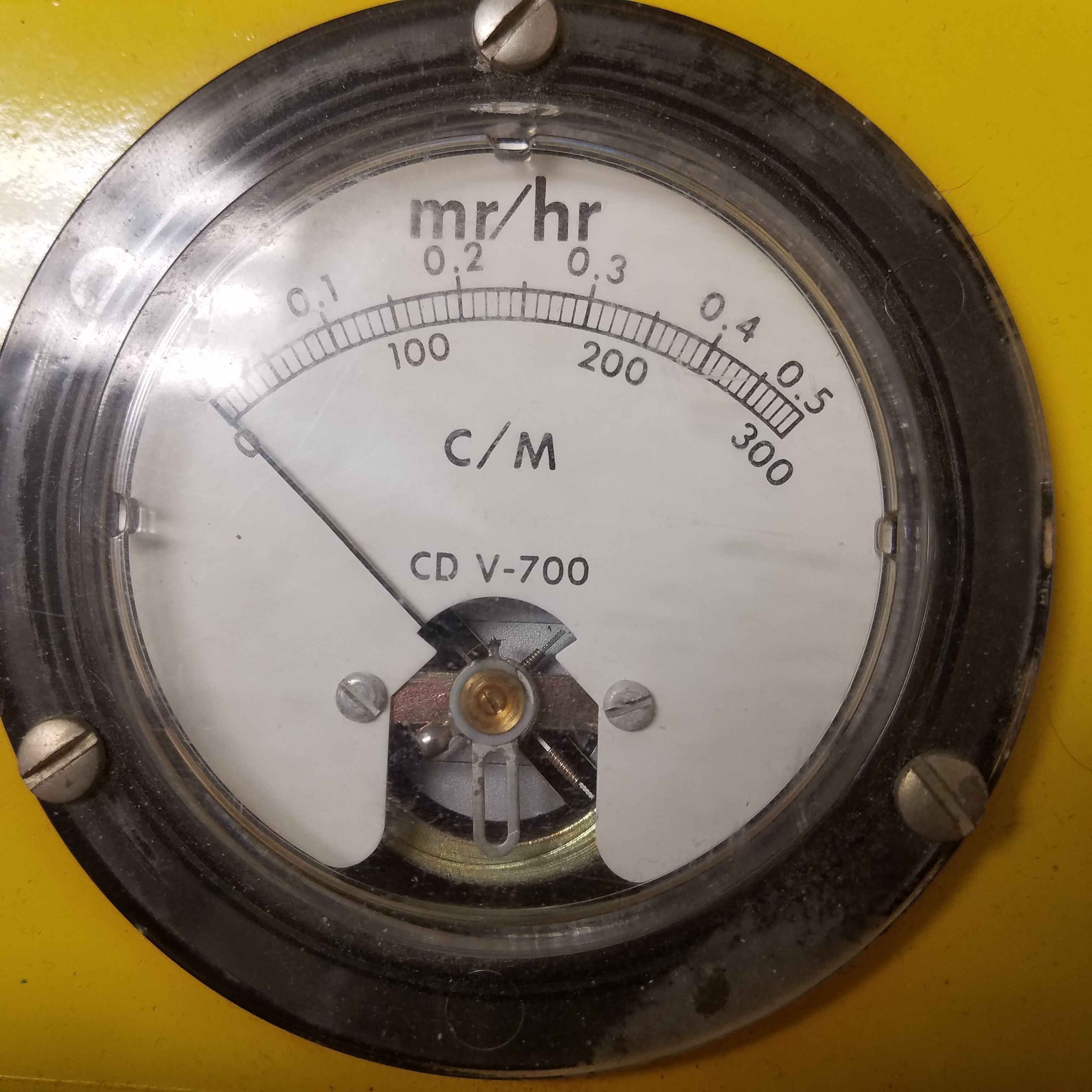
The scale on the gauge can be adjusted via the selector knob on the front panel of the device.
Like almost all Geiger counters, there is an audio source onboard. A large headphone port located at the bottom of the device allows you to connect a speaker or headset and here audible clicks every time a particle of radiation is detected. Unfortunately, this port is some strange 1950s headphone jack and not the familiar 3.5mm jack, so to use it you either need to buy an expensive adapter, buy a specially-made speaker/headset, or crudely solder two wires to the port and connect these to a piezoelectric buzzer to hear clicks. I of course chose the latter, and glued the buzzer to the side of the container to force the sound out the front. This speaker is usable, and serves its purpose even if it's not as good as an actual speaker (sadly I broke the poorly soldered wire off taking the detector apart for this post, but it's an easy fix).
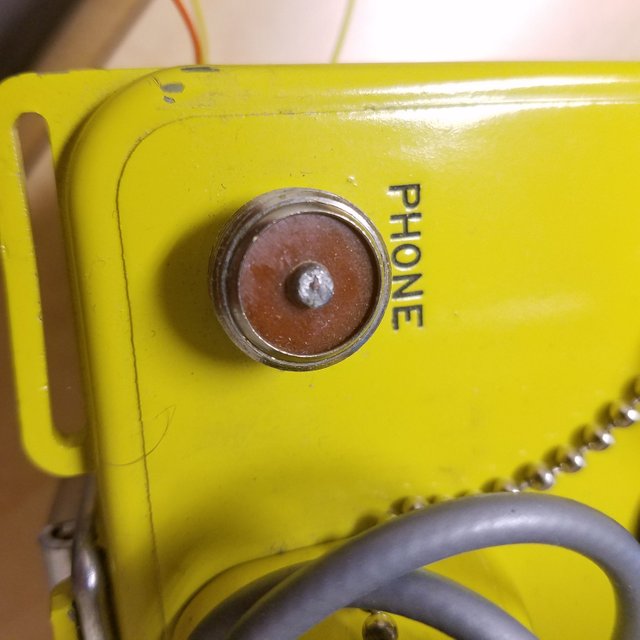
In order to keep the detectors properly calibrated, all CDV-700 detectors were shipped with a small sticker containing a radioactive source stuck to the side. By holding up the probe to the source, you can measure a known calibration reading and adjust the detector accordingly. My device contains a small slab of what I believe to be depleted uranium attached to the side, which emits a lot of beta radiation and can be used a check source to make sure that the detector is working.
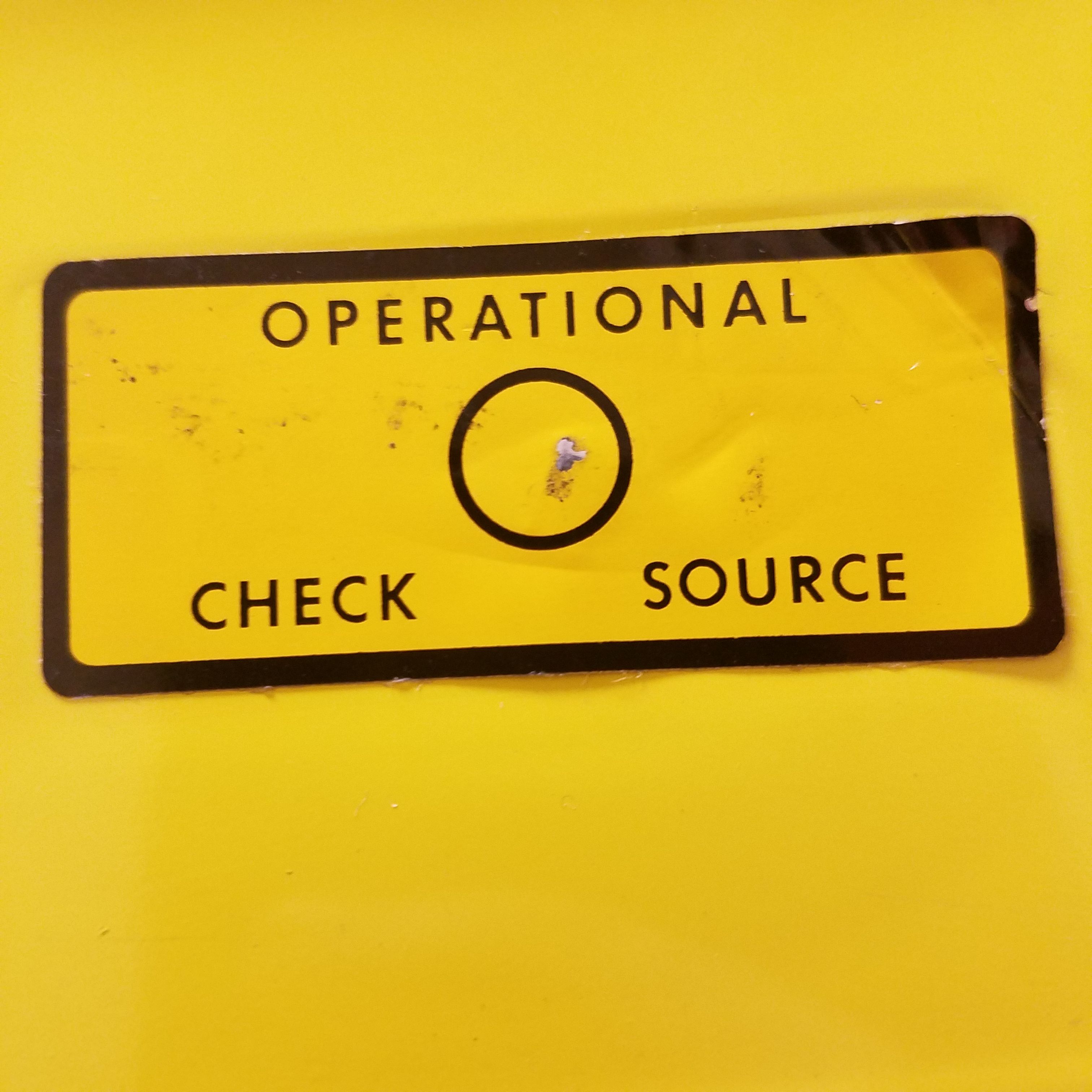
Depleted uranium check source on the side of the detector
As I mentioned in the Sintex detector teardown, older electronics often have a full electrical schematic included to make repairs simple. This device is no different, and a full schematic (with enough information to fully rebuild the CDV-700 from scratch) is available on the bottom of the container. Even though the detector appears to still be in the same state it was when it was made in 1961 and still works extremely, eventually something will break and need to be repaired. This is where the schematic comes in. Here is the schematic for your enjoyment:
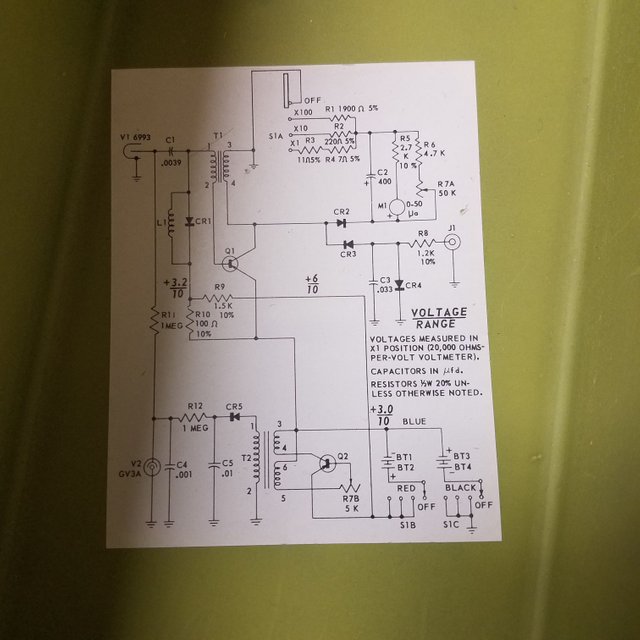
This schematic is inside the hollow battery cavity inside the device's external container along with the circuitry. This protects the schematic from water/rain and means that you will always have it on you as long as you have the detector handy.
The CDV-700 easily opens up by unclipping two clamps on the top and bottom. This reveals the schematic, a large battery bracket (taking 4 D-cell batteries) and all of the internal electronics. Unfortunately the front panel and D-cells cover most of the circuit, but I was able to get a few bad pictures from the side. You can identify these components on the above schematic if you like:
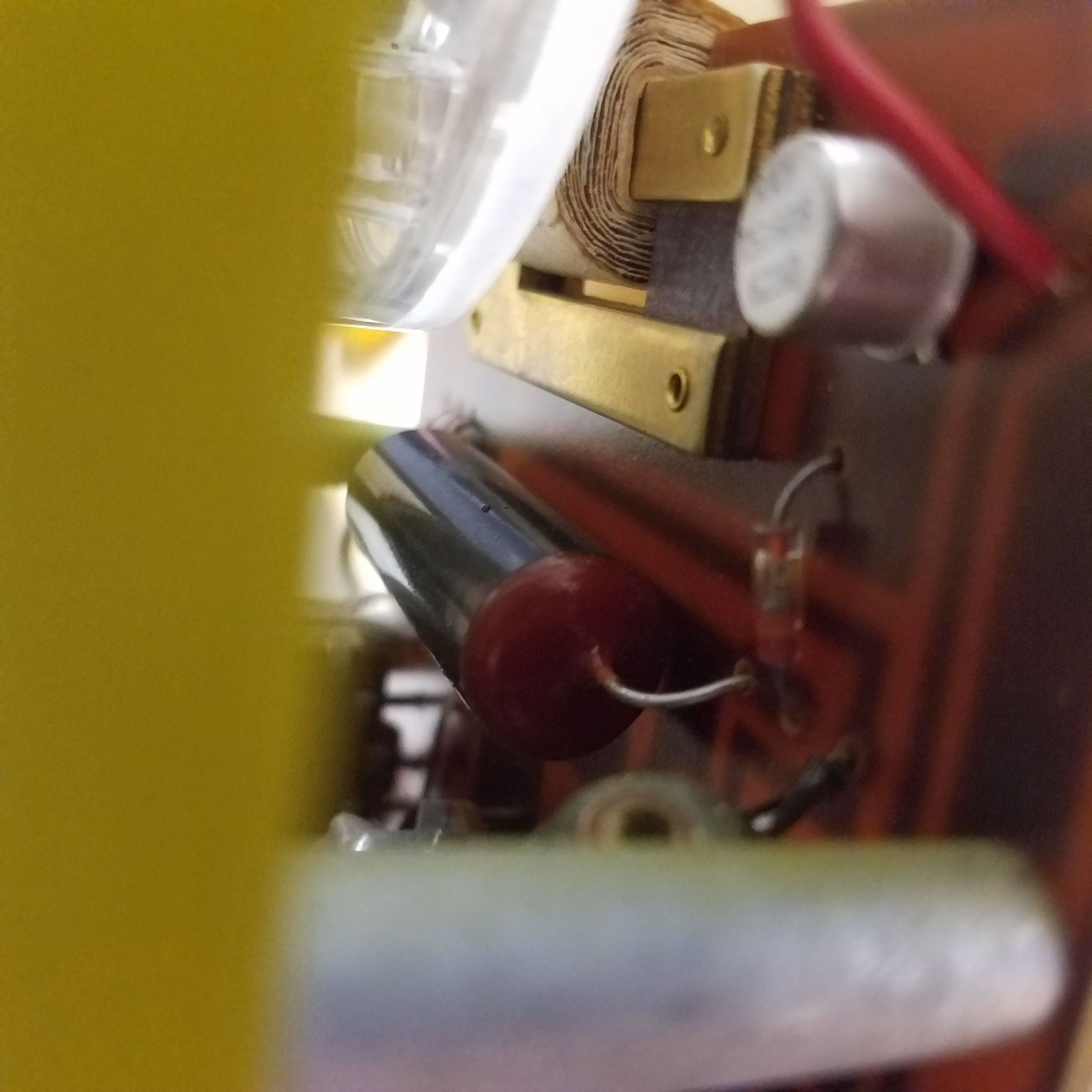
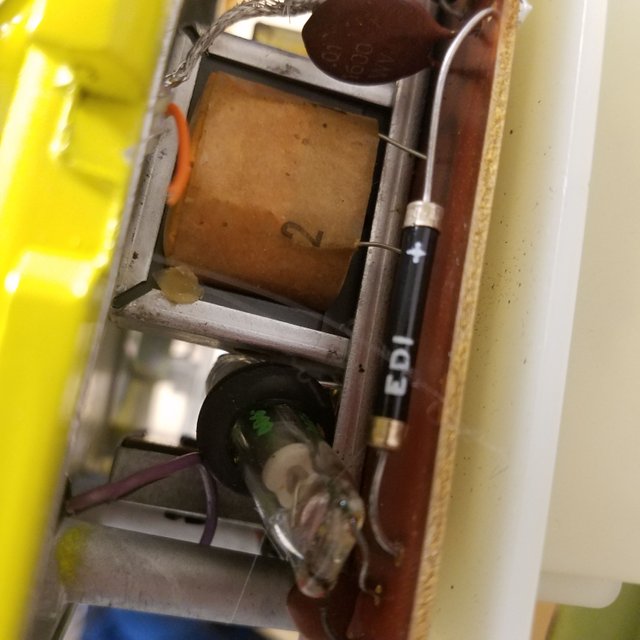
What can you use a CDV-700 for?
If you're somewhat of a paranoid type (and there's nothing wrong with that!), you can use the CDV-700 to protect yourself against possible nuclear power plant accidents or global nuclear war. While this won't protect you from being hit by a bomb, it will help you determine what places are safe after the initial blast. That being said the CDV-700 can saturate after a certain dosage (something around 50 mR/hr) and won't work properly, so if you tried to go right under where a nuclear missile went off this device would fail you.
You can also use it to find uranium ore outside. I have heard of deposits along the California-Nevada border in particular, but uranium occurs just about everywhere. Finding a rock radioactive enough to pick up would be a challenge though, and I've never attempted it.
I've used mine for:
- Detecting X-Rays from vacuum tube/high voltage combos
- Finding radioactive pseudo-scientific health stickers
- Checking that vacuum chamber plasma isn't irradiating me
- Checking various radiation sources like Am-241 buttons
- Trying to detect alpha particle induced nuclear reactions (no luck so far, as I chose a really bad reaction with a really low cross section to go after)
- Checking that my homemade Tritium-powered stuff isn't externally radioactive (it's not).
- General radiation experiments
So, this thing isn't really useful for most people. But, if you have $60 or so to spare and want to get into radiation experimentation, I highly recommend these surplus CDV detectors. Just make sure you get the 700 and not the 715 (the 715 is a gamma ion chamber that only works in ridiculously high, lethal radiation levels. These are meant to be used directly after a nuclear detonation and won't pick up any sources you can find). Many of them (like mine) still work extremely well after half a century of service, and they are so easy to repair given public schematics and easy to replace parts that they will likely be in use by hobbyists for a long, long time.
It's a useful tool for me to have and I find it interesting, but I'm sure that most people won't really need to own one of these. The CDV-700 is a lot more sensitive to radiation than the new Sintex detector I got, and as such will be better for measuring weaker sources.
Let me know if you have any questions or thoughts.
Thanks for reading!
All images in this post are my own. You are welcome to use them with credit.
Being A SteemStem Member
I'm late finding your interesting post.
Have been able to detect anything from Fukushima that got to Calif?
Maybe in some tuna or marlin or other pacific ocean items or etc?
I haven't checked any fish but I assume they would be insignificantly radioactive. Most things contain radioactive elements but aren't really radioactive in a detectable way because of the tiny amounts of radiation produced, so anything from Japan's reactor disaster would likely just raise the overall background radiation slightly. Unfortunately I don't have readings from before the earthquake to compare to.
Debris is another story, but I know that almost all of it has been confiscated to avoid contamination, so I unfortunately can't measure much.
Thanks for your reply.
It would be interesting to see the results of people around the world checking radiation levels of our food at markets and stores even if the levels are low, just to assure us it's safe or not. I don't think the government is checking.
Some larger fish travel long distances and might have passed through a highly contaminated area or ate other fish from a contaminated area. I would like think that is all being monitored, but is it?
Sometimes reports cause concern because maybe they aren't telling the whole story to avoid panic. Here's a news story from last year.
http://insider.foxnews.com/2017/02/08/unimaginable-levels-radiation-fukushima-pacific-ocean-leaks
And a video on youtube:
I can definitely check some driftwood the next time I'm at the beach (unfortunately I almost never buy fish due to being too busy/lazy to cook anything other than spaghetti haha) but I doubt the radiation will be detectable higher than background.
I noticed that map in the thumbnail lists radiation levels as Bq/m^3. The red zones were 10 Bq per m^3, so 10 decays per second per ton of water. I could be wrong, but I doubt this is even detectable on this detector - Am-241 sources containing over 30,000 Bq in a tiny point source are somewhat detectable but don't blow out the meter or anything. 10 Bq spread out among an entire cubic meter of water would be less radioactive than potassium salt at the store. I'm sure it would raise your cancer risk slightly over time if you drank it nonstop, but the human body contains enough potassium to easily outstrip this radiation source, unless the Cs-137 is being stored in the body for long periods of time.
I apologize if that was covered in the video but I honestly don't have time to watch it right now - massive amounts of work has piled up this week. I plan to come back and check this out later this week.
You're probably right that there's nothing in any of our food that would standout from background radiation. Maybe someday if you have some free time it might be interesting to show that our food is not dangerous because of Fukushima. It could be an interesting steemit post and a great informational video that others would also like.
If one day I decide to get a Geiger counter, I'll be looking for a CDV 700 because of your informative post.
Thanks
It would be kind of cool to go and find some Uranium Ore using one of these. Did you see Cody's Lab where he refined Uranium Ore into Yellowcake then into the raw metal ?
I did see the video, although I haven't taken the time to watch the entire thing yet as it was pretty long. Pretty incredible that he was able to do that.
Unprocessed Uranium ore itself is plenty radioactive to get picked up on the CDV-700 (I've tried it with some small pieces from a lab on campus that are easily detected by the device). Unfortunately I don't think there are very significant uranium deposits here in central CA, or at least not enough to go out and find some myself. I'll need to do some more research into possible spots up in the mountains perhaps where there are a lot of exposed rocks. For finding uranium though these Civil Defense Geiger counters are about as good as it gets when it comes to cost to performance ratio.
Awesome break down there mate!
I mean no shit! But still so cool :D
You made feel like love for a particular device is contagious. I just started loving CDV-700.
Nice post
Glad you enjoyed the post! I really do like this detector as it has served me very well.
Good information, have a nice day @proteus-h.
Follow back